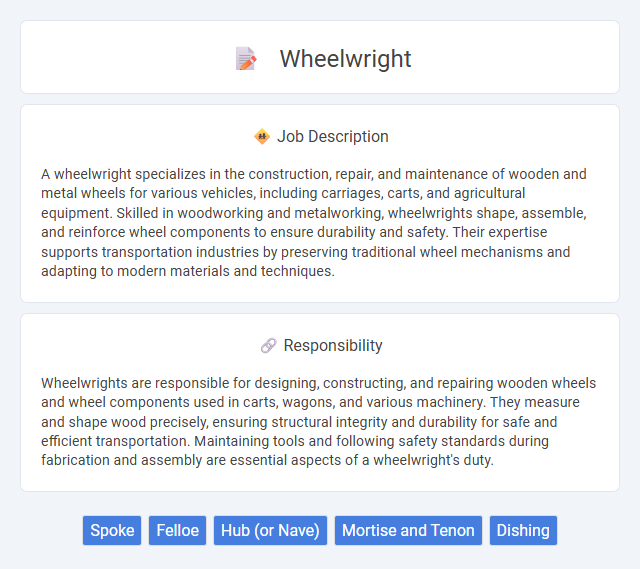
A wheelwright specializes in the construction, repair, and maintenance of wooden and metal wheels for various vehicles, including carriages, carts, and agricultural equipment. Skilled in woodworking and metalworking, wheelwrights shape, assemble, and reinforce wheel components to ensure durability and safety. Their expertise supports transportation industries by preserving traditional wheel mechanisms and adapting to modern materials and techniques.
Individuals with strong manual dexterity and an aptitude for working with tools might find wheelwright jobs well-suited to their skills. Those who enjoy precision craftsmanship and physical work could probably excel in this role, as it often involves repairing and constructing wooden wheels and carriages. However, people with limited strength or poor hand-eye coordination may struggle to meet the job's demands effectively.
Qualification
A proficient wheelwright typically requires formal training through vocational programs or apprenticeships focused on woodworking, metalworking, and machinery operation. Essential qualifications include expertise in crafting, repairing, and maintaining wooden and metal wheels, along with an understanding of historical and modern wheel designs. Advanced skills in using hand tools, wheel lathes, and precision measuring instruments are critical for ensuring durability and safety in wheel construction.
Responsibility
Wheelwrights are responsible for designing, constructing, and repairing wooden wheels and wheel components used in carts, wagons, and various machinery. They measure and shape wood precisely, ensuring structural integrity and durability for safe and efficient transportation. Maintaining tools and following safety standards during fabrication and assembly are essential aspects of a wheelwright's duty.
Benefit
A wheelwright job likely offers strong benefits such as specialized skill development and steady demand in industries like automotive restoration and traditional carriage making. Employees may experience job security due to the rarity of skilled wheelwrights and the continued need for their craftsmanship. Opportunities for working with diverse materials and custom projects could also enhance job satisfaction and career growth.
Challenge
Working as a wheelwright likely involves challenges related to the precision needed in crafting and repairing wheels to ensure safety and durability. The job may require adaptability to various materials and technologies, presenting a consistent learning curve. Physical endurance and attention to detail are probably critical factors that influence success in this trade.
Career Advancement
Wheelwrights can advance their careers by gaining expertise in advanced metalworking techniques and modern fabrication technologies. Pursuing certifications in welding, metallurgy, or mechanical engineering enhances job prospects and opens doors to supervisory or independent contractor roles. Experience with CAD software and understanding of vehicle restoration or industrial machinery maintenance further boost opportunities for leadership positions within manufacturing or restoration companies.
Key Terms
Spoke
A wheelwright specializes in assembling and repairing wheels with a focus on the spokes, which are crucial for distributing weight evenly and maintaining the wheel's structural integrity. Precision in fitting and tensioning wooden or metal spokes ensures optimal durability and performance for various wheel types, including those on carts, bicycles, and carriages. Expertise in spoke shaping, alignment, and replacement significantly enhances the wheel's strength and longevity.
Felloe
A wheelwright specializes in crafting and repairing wooden wheels, with particular expertise in the felloe--the outer rim segment that holds individual spokes. Precision in shaping the felloe is critical to ensure durability, balance, and proper alignment with the hub and spokes. Mastery of traditional woodworking tools and techniques enables wheelwrights to restore antique wheels or fabricate new ones meeting exact specifications.
Hub (or Nave)
A wheelwright specializes in crafting and repairing wooden wheel hubs, ensuring structural integrity and precise fit for axle assemblies. The hub, or nave, serves as the central component connecting spokes to the axle, requiring expertise in shaping durable materials like hardwood and metal fittings. Mastery in hub construction directly influences wheel performance, stability, and longevity in vehicles ranging from carts to traditional wagons.
Mortise and Tenon
A wheelwright specializes in crafting and repairing wooden wheels using traditional joinery techniques such as mortise and tenon, which ensure strong, durable connections between wheel components. The mortise and tenon joint is critical for fitting the spokes securely into the hub and the felloes, providing structural integrity and longevity. Precision in cutting and assembling these joints directly impacts the wheel's performance and safety, making expertise in this technique essential for skilled wheelwrights.
Dishing
A wheelwright specializing in dishing precisely adjusts the lateral offset of wheel rims to ensure proper alignment and optimal performance. Accurate dishing balances the wheel's center relative to the hub, preventing uneven wear and enhancing vehicle stability. Mastery of dishing techniques contributes to the longevity and safety of bicycle, motorcycle, and automotive wheels.
 kuljobs.com
kuljobs.com